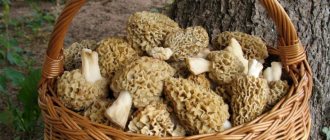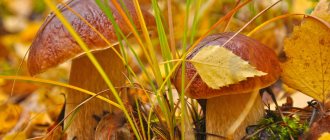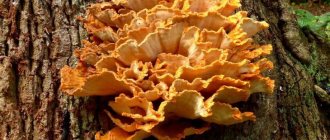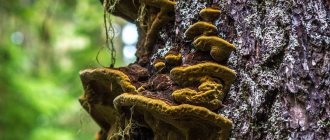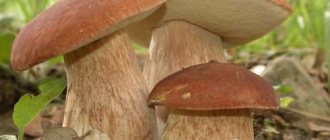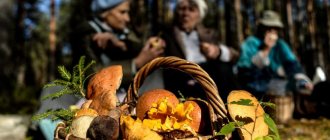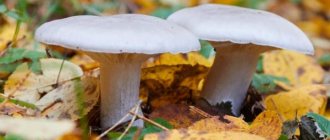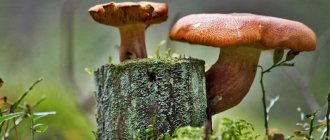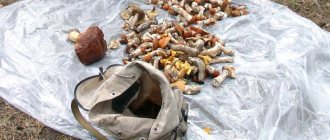Mushrooms
0
1308
Article rating
Kira Stoletova
Most mushroom pickers prefer to go on a “quiet hunt” in late summer or autumn. It is at this time that the largest number of edible mushrooms are found in the forest. However, some of their species begin to bear fruit in the spring. Edible mushrooms are rare in May, but this makes the “silent hunt” even more interesting and, if I may say so, more exciting.
Mushrooms in May
May mushroom
In Russia it is also called St. George's mushroom, May row and May kalocybe. The May mushroom season begins at the end of April and ends in July.
They grow mainly in the European part of the country; they can be found not only in the forest, but also in fields, meadows, and sometimes even in parks. Mushrooms gather in small groups and can form a ring or row. They prefer open areas, so there is no need to go deep into the forest - just walk along the edge.
The diameter of the cap of the May mushroom is approximately 5 cm. It has a flat-convex hump-shaped shape, but levels out as it ripens. The color is creamy at first, then white. The caps of old mushrooms may be ocher in color.
The plates near the stem usually grow. They are narrow and often spaced, at first they are whitish in color, then it turns into light ocher or cream.
The white pulp of the May mushroom is thick and dense. It tastes and colors like fresh flour.
The stems of May mushrooms are cylindrical in shape. They can reach 9 cm in length and 3 cm in thickness. The legs can narrow or widen downwards and are white, but at the base they often have an ocher or rusty-ocher tint.
Many people consider the powdery smell of May mushrooms to be a disadvantage, but it disappears with heat treatment. The raw materials must be cleaned of dirt and debris and pre-boiled for 20-30 minutes. May mushrooms can be fried, salted and pickled.
May mushrooms are suitable for home cultivation. If the technology is followed, the harvest can be harvested for several months.
Growing at home
May mushroom is one of the few species intended for growing at home. Following all the rules for growing will help you harvest for several months. The technology for growing Mayska row is simple and even a beginner can handle it. For the development of mycelium, it is necessary to maintain a temperature regime of +20°C. Within 2-3 weeks the mycelium will turn purple. At this time, it must be covered with a layer of earth of 0.5 cm. Future rows must be covered, protected from sunlight and temperature conditions created at 10-15 ° C. The first fruiting can be noticed after 3 weeks. After the first shoots appear, you can remove the shelter. Soil moisture is a very important condition when growing mushrooms. If the soil is too moist, the mycelium will not allow young shoots to emerge; if the soil is dry, young shoots will die. After each harvest, it is necessary to update the top layer of soil.
Sulfur-yellow tinder fungus
This mushroom is classified as conditionally edible. You can find it on a stump or tree trunk; it is usually located low.
The young mushroom is a drop-shaped fleshy mass of different shades of yellow. When the fruiting body hardens, the tinder fungus resembles an ear in shape. The fan-shaped pseudocaps are fused and usually sit on a common base.
The caps of sulfur-yellow tinder fungi can reach 40 cm in diameter. The mass of mushrooms can exceed 10 kg. You can always find a light creamy-yellow fluff on them.
Sulfur-yellow tinder fungi are distinguished by soft and juicy pulp, have a white color and a sour taste. At first, mushrooms are attracted by a slight lemony smell, but then it becomes unpleasant, reminiscent of a mouse.
As the tinder fungus ages, it becomes paler and its color is dull gray-yellow. The more isolated the fruiting bodies, the older the mushroom.
You should not collect sulfur-yellow tinder fungi from coniferous trees, or if they have already acquired a dark color or have an unpleasant smell. Such mushrooms can cause mild poisoning. This risk increases in childhood.
Only young sulfur-yellow tinder fungi are suitable for food. They can be fried, pickled, salted. The taste of the pulp is reminiscent of chicken, for which it is valued by vegetarians, and in some European countries it is even considered a delicacy.
Cooking tips
Even edible spring mushrooms need proper preparation before cooking:
- the twisting and folded fruiting bodies of strings and morels must be washed repeatedly and as thoroughly as possible with water, which will completely free them from accumulated forest debris and soil particles;
- Regardless of the type, it is recommended to boil washed and peeled mushrooms twice in salted water;
- It is not advisable to use mushroom broth obtained by boiling the first spring mushrooms for further preparation of first or second courses, as well as appetizers.
It should be remembered that poisoning can be caused by eating fruiting bodies that have a high concentration of heavy metals, pesticides and herbicides, as well as radioactive substances. Among other things, intoxication is often caused by the consumption of mushrooms contaminated with pathogenic microorganisms.
Scaly tinder
This mushroom is popularly called variegated tinder fungus, variegated tinder fungus, elm fungus, and hare fungus. You can find it on tree trunks; it is usually located low.
The fungus prefers deciduous trees and can settle on both living and dead trunks. This species is found in the middle zone and the Far East.
The scaly tinder fungus is distinguished by an asymmetrical fleshy cap, which can reach a diameter of 30 cm. At first, the cap is kidney-shaped, then it becomes prostrate and can be slightly depressed at the base.
The spongy cork pulp crumbles, it is soft only at the beginning, then it becomes harder. There is a mealy but pleasant aroma. Many people note that the aroma of the mushroom is reminiscent of fresh cucumbers.
The cap of the scaly tinder fungus is light yellowish or grayish in color. The entire surface is covered with wavy dark brown scales.
The mushroom stalk can reach a length of 10 cm and a thickness of 4 cm. The upper part of the stalk is reticulate and whitish, becoming brownish-black towards the base.
Only the young scaly polypore is edible. You can determine whether a mushroom is edible by pinching off a piece of the cap - it should crumble.
In terms of taste and nutritional properties, the caps of scaly polypores are of greater value. They can be fried, made into soup or cutlets. It is first recommended to grind the pulp and boil it.
Medicinal properties
Probably one of the important criteria for growing the May mushroom is the ability of its enzymes with the tuberculosis bacillus. Therefore, the row is actively used in the pharmaceutical industry for the production of antibiotics to combat tuberculosis. It has been scientifically proven that regular consumption of mayweed will help:
- remove waste and toxins from the body;
- restore liver cells;
- normalize gastric and intestinal tone;
- boost immunity.
- reduce nervous disorders;
- normalize blood sugar levels;
- strengthens bones and blood vessels;
- improve the condition of the cardiovascular system.
Important! The information presented in the material is for informational purposes only. Before use, be sure to consult a specialist.
May mushroom contains anti-cancer components that are widely used in Chinese medicine, using it to make medicines against cervical and ovarian cancer.
Medicinal properties of May row:
- anti-inflammatory;
- antiviral;
- antibacterial;
- antioxidant.
Pluteus deer
It is also called deer mushroom. It prefers the northern temperate zone and deciduous forests, gardens and parks. It can grow on tree trunks, stumps, branches, loves sawdust, wood chips, and cleared areas. The mushroom can be collected from late May to mid-autumn.
The diameter of the cap can reach 15 cm, in some species it is 20-24 cm. It has a wide bell-shaped shape, which then becomes convex or flat-prostrate. There is a small bump in the center. The surface of the cap attracts with its smoothness and silkiness. It is usually dry, but in humid weather it can be slightly mucous. The cap is often gray or grayish-brown. The color is darker in the center, the edges are striped and slightly ribbed.
The pulp is brittle and soft, has a white color that does not change when cut. The pulp from the stem is tougher and more fibrous. There is practically no aroma or taste, but sometimes there is a faint radish smell.
The mushroom stem can reach 5-15 cm in length and 1-2 cm in thickness. It can be easily separated from the cap. The leg is dense, cylindrical in shape, white or whitish-gray in color. There are longitudinal brown fibers, usually lighter towards the cap.
Deer whips are necessarily subjected to heat treatment. Mushrooms can be boiled, stewed or fried. They do not have any special taste, so they are usually used for preparing complex dishes.
Mushroom picker calendar
The 2022 mushroom picker's calendar will help you decide when and what mushrooms to collect, when they are just starting to grow, and when they bear mass fruit. What you come home with from the “silent hunt” depends on this (and also on the weather and location). As practice shows, mushrooms grow almost all year round. But not everyone knows about this, and they lose the opportunity to enjoy wild mushrooms, no matter what time of year it is outside. I think many will agree that the mushroom season can be called the end of summer and all autumn until the first frost. At this time, people collect mushrooms en masse in years when the weather allows it. But some species cannot be found either in summer or autumn.
Spring honey fungus
It is also called forest-loving, oak-loving or oak-loving collibia, common money. It can usually be found from late May to late autumn. These mushrooms grow in small groups, preferring rotten wood or leaf litter.
The cap of the spring honey mushroom can reach 7 cm in diameter. In young mushrooms it is convex, then becomes broadly convex and flat. The color is initially red-brown, then becomes orange-brown or yellow-brown as it fades.
The pulp is white or yellowish in color and has no pronounced taste or aroma. The leg can reach 9 cm in length and less than 1 cm in thickness. It is flexible, can be flat or slightly widened towards the base.
The mushroom is conditionally edible. It must be pre-boiled for a quarter of an hour. Without such preparation, the mushroom has an unpleasant taste and can lead to mild stomach upset. Spring honey fungus can also be dried.
Honey fungus
This mushroom is also called meadow mushroom, meadow rotten mushroom, clove mushroom, meadow marasmius. You can meet it from late May to mid-autumn. The mushroom prefers open grassy spaces - meadow, pasture, pasture, vegetable garden, garden, edge, roadside. Grows on soil.
The cap of the meadow honey fungus can reach 5 cm in diameter. It is smooth and hemispherical, then becomes convex, and in maturity – flat-spread. In dry weather, the mushroom cap is pale cream; in damp weather it becomes sticky and acquires a yellowish-brown or reddish-ocher color. Regardless of the weather, the edges of the cap are lighter than the center.
The meadow honey fungus sits on a thin and high stalk. It can reach a height of 6 cm, with a thickness of no more than half a centimeter. The leg has a cylindrical shape and may be slightly tortuous. It is dense and slightly thickened towards the base.
The pulp is thin, pale yellow or whitish in color, which does not change when cut. It has a light sweetish taste and a strong, unique aroma, reminiscent of bitter almonds or cloves.
Only the caps of the meadow honey fungus are eaten. They can be recycled in any way.
Common garlic
This mushroom was given its name due to its characteristic garlic smell. Garlic is small in size. Its cap rarely reaches more than 2.5 cm in diameter. At first it has a convex-conical or hemispherical shape and a tucked edge, then convex and flattened with an irregularly wavy edge.
The cap usually has a bare and smooth surface. The color is varied - with humidity it can be from pinkish-brown to ocher-red. In dry weather, the color of the cap is cream or ocher.
Mushrooms are distinguished by very thin flesh of the same color as the surface. Garlic is not only a smell, but also a taste.
The garlic stalk usually does not exceed 5 cm in height and 2 mm in thickness. It has a cylindrical shape and a rigid structure. The leg is bare and shiny, orange at the top and reddish-brown at the bottom.
Garlic prefers coniferous and deciduous forests, choosing pine needles, twigs, rotting bark, and sometimes grass.
This mushroom is often dried to be used later as a seasoning for various dishes. The attractiveness of this method of harvesting is that after a few minutes in water the mushrooms become fresh again. Garlic can be fried, including with other mushrooms. It is not recommended to boil it, as this treatment loses its attractive aroma.
Morel
It is considered a conditionally edible mushroom, as it requires pre-cooking for 15 minutes before further heat treatment. Raw morels do not have a distinct taste or smell, but when cooked their aroma and taste are very good.
This species can be found in deciduous and coniferous forests on the edges, between trees, in mossy and burnt areas. Prefers humus or sandy soil with sufficient moisture. You can often find morels along highways and roads, in logging areas. In general, the area should be well lit by the sun.
You can collect forest gifts from early April to early June. And if the winter is warm enough, then the first morels appear at the end of March. Sometimes colonies of mushrooms grow in September-October. However, as soon as lush greenery appears in the spring, the growth of this species ends.
Important! The most favorable time for collection is April. The growth of morels lasts only a couple of weeks, before the mass appearance of greenery, so it is important not to miss the harvesting season. The mushroom belongs to the morel family, the most common type is the common (real) morel, but there are also other types: conical and delicate morel, morel thick-legged and semi-free
These types may differ slightly in the shape of the folds on the cap and the shape of the cap. The cap of ordinary morels can be spherical or oblong, with numerous indentations of various shapes. The color can be different: from all shades of yellow and brown to gray-brown. The older the mushroom, the darker the cap. Its size does not exceed 5-8 cm in height and 4-8 cm in diameter. The leg grows from 3 to 9 cm, in diameter - up to 3 cm, and is colored yellow or white. The cap and stem are empty inside and form one common cavity
The mushroom belongs to the morel family, the most common type is the common (true) morel, but there are also other types: conical and delicate morel, cap morel, thick-legged and semi-free morel. These types may differ slightly in the shape of the folds on the cap and the shape of the cap.
The cap of ordinary morels can be spherical or oblong, with numerous indentations of various shapes. The color can be different: from all shades of yellow and brown to gray-brown. The older the mushroom, the darker the cap. Its size does not exceed 5-8 cm in height and 4-8 cm in diameter. The leg grows from 3 to 9 cm, in diameter - up to 3 cm, and is colored yellow or white. The cap and stem are empty inside and form one common cavity.
Learn more about morel varieties and differences from stitches.
You can prepare any dishes from these spring mushrooms: when fried or stewed, they complement side dishes well, they can be frozen, dried, or pickled.
boletus
This mushroom can be found in May under favorable weather conditions. It is popularly called birch and blackhead. You can meet it in a light deciduous or mixed forest where there are birch trees.
You can collect boletus mushrooms from the end of May. The signal for the appearance of such mushrooms is the flowering of bird cherry.
The mushroom is spongy. Its cap can reach a diameter of 15 cm. Depending on the type of mushroom, its color can be from white to dark gray, close to a black tint. The color darkens as it matures. If the air is humid, mucus appears on the cap and it becomes sticky to the touch.
The leg is white, slightly thickened at the bottom. There are longitudinal scales of white or black color. The stem has a cylindrical shape, can reach 15 cm in height and up to 3 cm in thickness. In old mushrooms, the pulp of the stem becomes hard and fibrous.
The pulp is white in color, which does not change when cut. If the area is swampy, then the mushroom may have pinkish flesh at the break. This type of boletus is called pinkish boletus. In mature mushrooms, the pulp becomes watery and loose.
Boletus mushrooms can be prepared in different ways. Mushrooms are suitable for drying, frying, boiling and pickling.
Greenfinch
It is also a row of green, yellow or lemon. Cinderellas are typical autumn mushrooms that bear fruit until the very first light frosts - when other edible mushrooms are no longer available. It happens that greenflies are collected from under the snow.
Mycorrhiza forms with coniferous trees, mainly with pine trees. Prefers to grow on sandy or sandy loam soils. It appears most abundantly in forests from September to November.
Lately there has been talk around the greenfinch about its toxicity. European researchers claim that it can be poisoned, especially if you eat a large amount of mushrooms. In our country, this mushroom has been considered edible for centuries, however, experts strongly recommend consuming greenfinch only after pre-treatment (boiling) and in moderate quantities.
Oiler
The butterdish is often called yellow, late, autumn, real. They usually start collecting it in the summer, but in May the mushroom can be found in sunny forest clearings.
The oiler's cap can reach a diameter of 14 cm. Its shape is hemispherical, then becomes round or flat-convex or cushion-shaped, less often flat or tuberculate. The surface is smooth and slimy to the touch. The color of the cap can be various shades of brown, red-brown, gray-brown, brown-olive, yellow-brown.
The skin can be easily separated from the pulp, which attracts with its softness, juiciness, and has a whitish or yellowish color. The flesh of the leg is slightly fibrous, and at its base has a rusty-brown color.
The oiler leg can reach 11 cm in height and 2-2.5 cm in thickness. It has a cylindrical shape, whitish or yellowish color. There is a film ring. It starts out white, then turns brownish, black-brown, or dirty purple.
Among edible mushrooms, butterdish is very popular. It is fried, salted, pickled, added to soups, side dishes, marinades after preliminary boiling (10 minutes is enough). For pickling and pickling, it is better to choose young mushrooms - they have better taste.
How to distinguish edible species
Mushrooms are not only tasty, but also very healthy food. They contain substances such as salts, glycogen, carbohydrates, as well as vitamins of groups A, B, C, D. If the mushrooms are young, then they also contain many microelements: calcium, zinc, iron, iodine. Their intake has a beneficial effect on the body's metabolic processes, increasing appetite, functioning of the nervous system and gastrointestinal tract.
Forest edible mushrooms
In fact, there are no exact criteria by which one can distinguish safe mushrooms from poisonous ones. Only existing knowledge about the appearance, characteristics and names of each species can help in this matter.
Characteristics of edible mushrooms
General criteria for edible mushrooms include:
- No sharp bitter smell or taste;
- They are not characterized by very bright and catchy colors;
- Typically the inner flesh is light in color;
- Most often they do not have a ring on the stem.
But all these signs are only averaged, and may have exceptions. For example, one of the most poisonous representatives, the white toadstool, also has no pungent odor at all and its flesh is light.
Another important point in this matter is the growing area. Typically, edible species grow far away from their dangerous counterparts. Therefore, a proven harvest location can significantly reduce the risk of encountering poisonous mushrooms.
Common Misconceptions
There are many popular signs and non-standard ways of determining the safety of mushrooms. Here are the most common misconceptions:
- Silver spoon. It is believed that it should darken upon contact with an inedible mushroom;
- Onion and garlic. They are added to the mushroom broth and if they darken, it means there is a poisonous species in the pan. It is not true;
- Milk. Some people believe that when a mushroom that is dangerous to humans is placed in milk, it will definitely turn sour. Another myth;
- Worms and larvae. If they eat certain types of mushrooms, then they are edible. But in fact, some species edible by worms can harm human health.
White dung beetle
This mushroom can be found at the end of May. It prefers loose soil rich in organic matter and the northern temperate zone. Usually it is found not in the forest, but in a pasture, park, garden or vegetable garden.
The cap of the white dung beetle can reach 10 cm in diameter and 15 cm in height. It has an elongated ovoid shape, which then becomes narrow bell-shaped. The mushroom may be white, gray or brownish in color with a brown bump on top. Fibrous scales are densely located on the surface.
The pulp is white, soft, and has no special taste or smell. The leg can reach 20-30 cm in height and 2 cm in diameter. It has a cylindrical shape, white color, silky sheen and a cavity inside.
Because of its appearance, the mushroom in Russia has long been classified as a toadstool and considered poisonous, although in some European countries it is called a delicacy. It should be eaten only when young, until the plates are white and have not begun to turn pink. Processing should begin within the first 2 hours after collecting mushrooms.
White dung beetle is considered conditionally edible, so it is recommended to boil it first. Do not use it with other mushrooms or alcohol.
In May you can pick certain types of mushrooms. It is important to take into account their characteristics and collect them within the recommended period. Cooking methods for different types differ; some mushrooms must be boiled first.
0
0
Copy link
Time and place of fruiting
You can start collecting May mushroom in the second half of April and until the beginning of summer. The rows form heaped groups, but can be found individually and in the form of “witch rings.” Its prevalence is extensive and does not have a specific sign, the main thing is that the sun hits: the edge of a forest (coniferous or deciduous), short grass, country roads, the outskirts of fields.
Summer residents can also find a T-shirt in their garden or garden.
In the Crimea, which is popular for lovers of quiet hunting, it can be found in humus soils, in thickets, in the forest it likes to breed on limestone and in old, almost rotten foliage. Not tied to a specific tree species, like many species.

